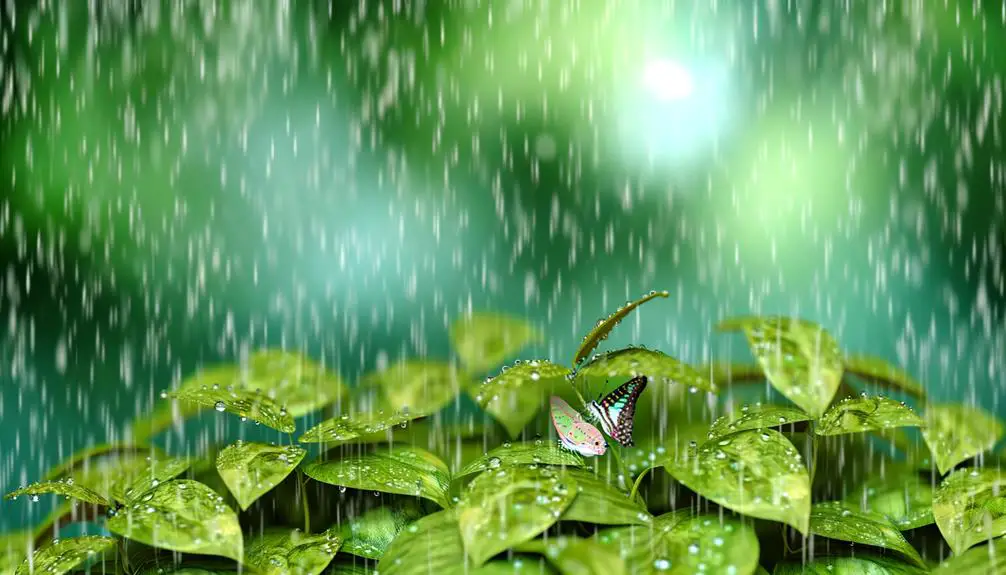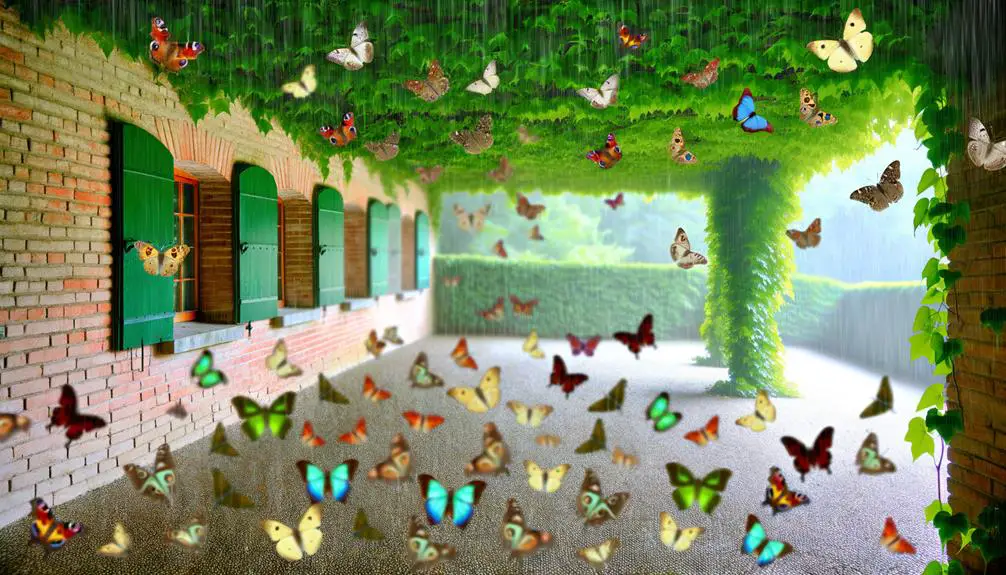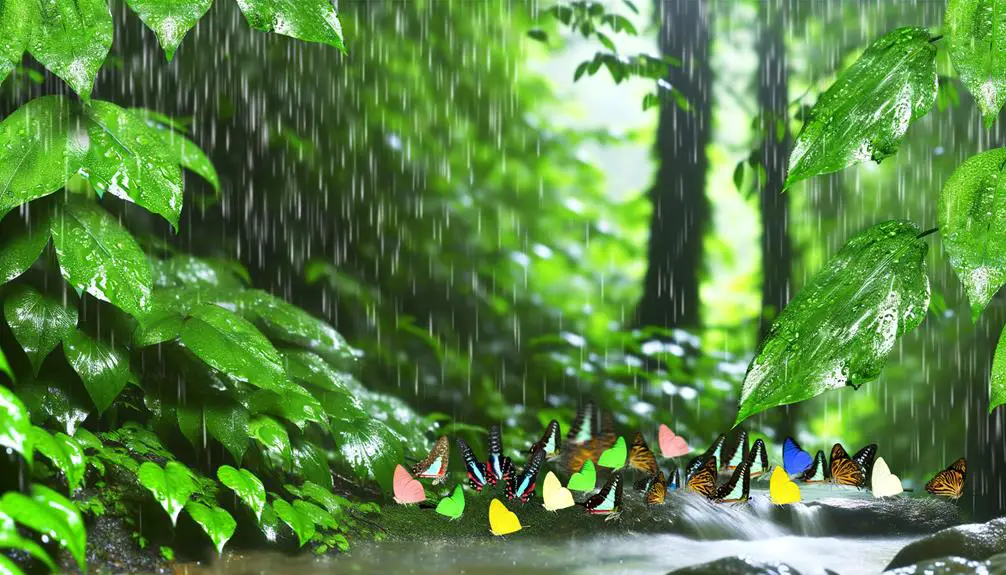Where Do Butterflies Go When It Rains?
When rain approaches, butterflies utilize various strategies to mitigate its impact. They seek natural shelters such as crevices in tree bark, the undersides of large leaves, and dense foliage, which provide protection from raindrops and wind.
Urban butterflies find refuge in man-made structures like eaves, overhangs, and windowsills where they avoid direct exposure to water. These hiding behaviors help them manage the risk of wing damage, flight disruption, and energy depletion.
To understand more about their survival strategies and the critical role their wing structures play in these adaptations, further exploration into their behavior during adverse weather conditions is essential.

Key Takeaways
- Butterflies seek shelter under dense foliage to avoid rain.
- Tree bark crevices provide secure hiding spots for butterflies during rain.
- Large leaves act as natural umbrellas, keeping butterflies dry.
- Urban butterflies take refuge under building eaves and overhangs.
The Challenges Rain Brings

When it rains, butterflies face significant challenges, including the risk of wing damage, disruption of flight, and reduced access to essential resources like nectar.
The delicate structure of butterfly wings, composed of thin layers of chitin and covered in microscopic scales, is highly susceptible to water damage. Moisture can weigh down the wings, making flight difficult or impossible, therefore increasing vulnerability to predators.
Additionally, rain can wash away nectar from flowers, which is a critical energy source for butterflies. This disruption forces butterflies to expend more energy searching for alternative food sources.
Furthermore, prolonged wet conditions can lead to hypothermia, as butterflies are ectothermic and rely on external temperatures to regulate their body heat. This can be especially dangerous in cooler climates or during extended periods of rain when butterflies struggle to absorb enough warmth from their surroundings. In some cases, butterflies landing on humans may be an attempt to seek warmth or dry surfaces to rest on. Without adequate warmth, their metabolism slows down, making it difficult for them to fly and find nourishment.
Understanding these challenges highlights the need for conservation efforts.
Finding Natural Shelters
Butterflies seek refuge in natural shelters such as dense foliage, tree bark crevices, and under large leaves to protect themselves from the adverse effects of rain.
These microhabitats provide essential cover from raindrops, which can be detrimental due to their relative size and impact force.
Dense foliage acts as a barrier, reducing the direct exposure to rain, while tree bark crevices offer a more secure hideaway, protecting butterflies from both rain and wind.
Additionally, the undersides of large leaves serve as umbrellas, shielding them from direct precipitation and maintaining a more stable microclimate.
Hiding Under Leaves

Among the various natural shelters utilized by butterflies during rainfall, the underside of large leaves provides a particularly effective form of protection. This strategy is beneficial due to several key factors:
- Water Resistance: Large leaves often have hydrophobic surfaces that repel water, keeping the butterfly dry.
- Wind Barrier: The leaf structure serves as a shield against strong winds, reducing the risk of physical harm.
- Temperature Regulation: Leaves can moderate temperature fluctuations, offering a more stable microenvironment.
- Predator Concealment: Hiding under leaves helps butterflies evade predators that are more active during rain.
These factors collectively enhance the butterfly's survival during adverse weather conditions, demonstrating an evolved behavioral response to environmental stressors.
Taking Refuge in Trees
Trees offer a multifaceted sanctuary for butterflies during rainfall, providing both physical protection and microclimatic stability. The dense foliage acts as a barrier against raindrops, reducing the impact force and preventing potential damage to delicate wings.
Additionally, the canopy moderates temperature fluctuations and humidity levels, creating a more stable microenvironment. Tree bark and crevices also offer hiding spots, where butterflies can cling to rough surfaces, minimizing exposure to wind and water.
These natural features collectively create an ideal refuge, ensuring butterflies can conserve energy and avoid hypothermia. By utilizing the intricate structure of trees, butterflies enhance their chances of survival during inclement weather, demonstrating an adaptive behavior finely tuned to their ecological needs.
Safe Spots on Buildings

In urban environments where natural refuges may be scarce, architectural structures such as buildings offer critical sheltering spots for butterflies during rainfall. These structures provide various microhabitats that can effectively shield butterflies from adverse weather conditions.
Common safe spots include:
- Eaves and Overhangs: These protruding parts of buildings prevent direct exposure to rain and wind.
- Windowsills: Often recessed, providing a dry and relatively calm environment.
- Balconies: Offer covered areas that can serve as temporary refuges.
- Ventilation Shafts: Small openings that can protect butterflies from heavy rainfall.
These artificial refuges are essential for the survival of butterflies in urban landscapes, particularly during inclement weather, when natural shelters might be insufficient or unavailable.
Utilizing Human Structures
Butterflies often seek refuge from rain by utilizing human structures, such as buildings, which provide ample shelter from adverse weather conditions.
They can commonly be found hiding in eaves and other architectural features that offer protection from precipitation.
This behavior underscores the adaptability of butterflies in urban environments, leveraging man-made constructs to guarantee their survival during inclement weather.
Shelter in Buildings
During rainfall, many butterflies seek refuge in human-made structures such as barns, sheds, and even the nooks and crannies of residential buildings. These environments provide critical protection from the elements, allowing butterflies to conserve energy and avoid damage to their delicate wings.
The specific areas within these structures that butterflies gravitate towards include:
- Corners and crevices: Small gaps offer tight, secure spaces.
- Under eaves or overhangs: These areas shield against direct rain exposure.
- Behind shutters or loose siding: These locations offer additional layers of protection.
- Inside open garages or barns: Such spaces provide ample room and reduced wind exposure.
This behavior highlights the adaptive strategies butterflies employ to survive inclement weather, utilizing available human-made refuges effectively.
Hiding in Eaves
Human structures, particularly eaves, serve as critical shelters for butterflies during rainfall, offering protection from wet conditions and wind.
Eaves provide a dry, stable environment that shields these delicate insects from the detrimental effects of water exposure, which can impair their ability to fly and regulate body temperature.
By utilizing the overhangs of roofs and similar architectural features, butterflies can avoid the direct impact of raindrops, which pose a significant physical threat due to their size relative to the insect.
This behavior highlights the adaptability of butterflies in urban environments, where natural shelters may be scarce.
Additionally, eaves often offer reduced wind exposure, minimizing the risk of being dislodged from their resting spots during inclement weather.
Clinging to Stems and Stalks

When it rains, many butterflies exhibit an adaptive behavior by clinging tightly to the stems and stalks of plants to avoid being dislodged by the downpour. This natural strategy is essential for their survival, as it minimizes exposure to potentially harmful elements and conserves energy.
The stems and stalks provide:
- Structural Support: Offering a stable anchor, reducing the likelihood of being swept away.
- Microclimatic Shelter: Creating a microhabitat that shields them from direct rain and wind.
- Camouflage: Helping them blend into the environment, reducing predation risk.
- Temperature Regulation: Assisting in maintaining body temperature by staying close to the ground.
These behavioral adaptations underscore the intricate relationship between butterflies and their habitats, enabling them to endure adverse weather conditions.
The Role of Butterfly Wings
Integral to their survival, butterfly wings play a critical role in weathering rainstorms through structural and behavioral adaptations.
The wings are covered in tiny, overlapping scales that create a water-resistant barrier, minimizing water absorption and preventing damage. The microstructure of these scales allows water droplets to bead and roll off, maintaining the integrity of the wings.
Additionally, the wings' lightweight yet robust construction aids in reducing the impact of raindrops. Their ability to fold their wings vertically over their bodies offers further protection, reducing surface area exposure to rain.
These adaptations are essential, as excessive moisture can hinder flight capabilities and increase the risk of predation, thereby influencing the overall survival of butterflies during inclement weather.
Behavior During Rainy Weather

In addition to their structural adaptations, butterflies exhibit specific behaviors during rainy weather that further enhance their survival prospects. These behaviors are critical for minimizing exposure to the elements and conserving energy.
The key strategies include:
- Seeking Shelter: Butterflies often take refuge under leaves, in crevices, or within dense foliage to avoid direct contact with rain.
- Closing Wings: To reduce water accumulation, butterflies close their wings tightly, creating a streamlined surface.
- Staying Stationary: Remaining motionless helps conserve energy and avoids attracting predators.
- Utilizing Camouflage: By blending into their surroundings, butterflies decrease their visibility to predators during vulnerable periods.
These behavioral adaptations are integral to their survival, ensuring that butterflies remain protected and can resume normal activities post-rainfall.
Conclusion
In the dance between delicate wings and relentless rain, butterflies epitomize resilience.
Utilizing the canopy of nature's architecture—leaves, trees, and stems—alongside man-made sanctuaries, they transform adversity into shelter. Their wings, akin to fragile yet resolute shields, play a pivotal role in survival.
This interplay of vulnerability and strength underscores a delicate equilibrium, revealing an intricate choreography where each raindrop shapes the narrative of endurance.
Consequently, butterflies encapsulate nature's silent proof to adaptability amidst turmoil.






